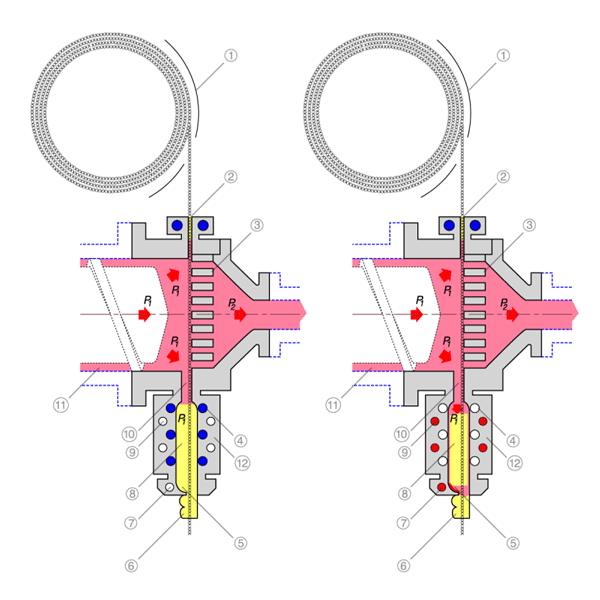Operating Principle of HITECH™ Continuous Screen Changers for the Filtration of Thermoplastics
HITECH™ screen changers have set the standard for continuous melt filtration since 1969.
They operate in a fully automatic mode, requiring no operator attention. There is no external driving mechanism or power source such as hydraulic power or an air cylinder in a HITECH™ unit. Instead, the force of the extruder head pressure is used to move the filter screen. Having no moving parts or mechanism, there is nothing to wear, no associated downtime for maintenance.
The only element that moves in a HITECH™ screen changer is the screen itself. There are no hot breaker plates or dirty screen packs to handle. Screens are furnished in 120’ (36 meter) long rolls that have an effective filtration area equivalent to many hundreds of individual screen packs and typically last several months in non-stop operation.
The automatic movement of the filter screen is set to cycle at a rate which smoothly blends with the melt flow. In addition, the rate of screen advancement automatically adjusts to correspond to fluctuations in extruder head pressure resulting from clogged screen. In this way, perfectly uniform head pressures and melt temperatures are maintained throughout months of non-stop operation.
HITECH™ screen changers do not employ mechanical or “metal-to-metal” seals. Instead, cold circulating water is used to form perfectly leak proof polymer seals. As a result, these machines are not subject to the leakage problems normally associated with other types of screen changers. The polymer seals will not cause wear to the screen changer, and HITECH™ screen changers are unconditionally guaranteed not to leak polymer in ten years of continuous operation.
HITECH™ screen changers use a long, Dutch weave stainless steel screen (xxxxx) to filter contaminants from the melt. Molten plastic flows through the screen and the holes of the stationary breaker plate (3). Hot plastic also enters into the cooling chamber (12) through the slot (10). Here, cooled by circulating water (4), the plastic quickly hardens into a solid plug (8).
Cold water also circulates around the narrow slot where the screen enters the screen changer (2). The hot plastic quickly freezes as it touches the cold steel walls, forming perfectly leak-proof seals.
When the heater cartridges (7) and (9) are turned on, the outer layer (5) of the plastic plug (8) soon begins to soften. As soon as this thin layer of plastic is soft enough to flow, the plug is squeezed out (6) by the extruder head pressure P1. When the heaters (7) (9) are turned off and the circulating water (4) is turned on, the steel cools completely, and the movement of the plastic plug stops.
As the plastic plug slides forward inside the chamber (12), it pulls along the screen that is embedded in it. At the same time, clean screen is pulled from the canister (1) and gradually enters the melt flow.

SCREEN STATIONARY SCREEN ADVANCING
